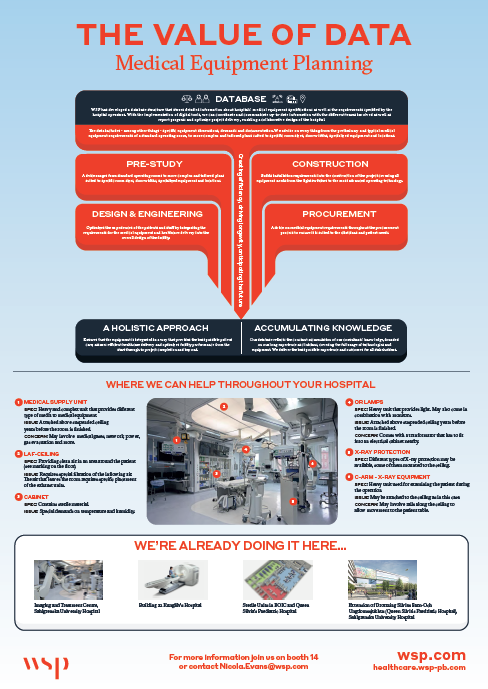Healthcare / Planning and mapping
European Healthcare Design 2018
Medical equipment planning – the value of data
By Sara Wennergren | 08 Jun 2018 | 0
A lot of time and money is invested in building new hospitals and many bring with them new challenges, including new technologies and increasingly integrated system requirements. The challenge is how to streamline the planning process for hospitals’ medical equipment.
Abstract
Medical equipment planning – the value of data
A lot of time and money is invested in building new hospitals and many bring with them new challenges, including new technologies and increasingly integrated system requirements. The challenge is how to streamline the planning process for hospitals’ medical equipment.
From renovations to new builds, it’s critical to work directly with clinical staff and hospital consultants to understand their needs and ensure the equipment is integrated in a way that provides the best possible patient care, ensures efficient healthcare delivery, and optimises facility performance. A comprehensive understanding of medical equipment specifications, the complex systems, and latest technologies is needed to bridge the gap between hospital stakeholders and contractors. But is there a way to make the process even more efficient and make the most of hospital consultants’ knowledge to save time?
One solution is the development of a database structure that stores detailed information about hospitals’ medical equipment specifications, as well as the requirements specified by hospital operators. With the implementation of digital tools, we can co-ordinate and communicate up-to-date information with the different teams involved, as well as report progress and optimise project delivery, enabling a collaborative design of the building.
The data includes anything from equipment weight, necessary to ascertain the effect on room structures, for example, to the number of people who will work in the room, potentially affecting ventilation systems. The database supports knowledge on everything from the preliminary and typical medical equipment requirements of a standard operating room, to more complex and tailored plans suited to specific room sizes, door widths, specialised equipment, and locations. Installing an MRI on the fourth floor of a building requires, among other things, installation during construction, control over the magnetic fields, and emergency ventilation in case of a helium leak.
One case study project is the construction of Queen Silvia’s Children’s Hospital in Gothenburg, which includes hybrid operation theatres, a sterile unit, and is one of two paediatric heart centres in Sweden. This paper will demonstrate how knowledge was collated and interrogated to support the digital room function programme, and the project planning and installation instructions for the entire building’s medical equipment.
In conclusion, during the planning phase and installation process of hospitals’ medical equipment, we make use of digital tools to store project data and specifications to reuse on new projects. Increased complexity and increasingly high-tech equipment demand detailed knowledge but also benefit from simpler systems and environments. Only a small adjustment can have a huge impact on cost if it’s carried out too late, and therefore pre-empting these requirements is essential.
Organisations involved


